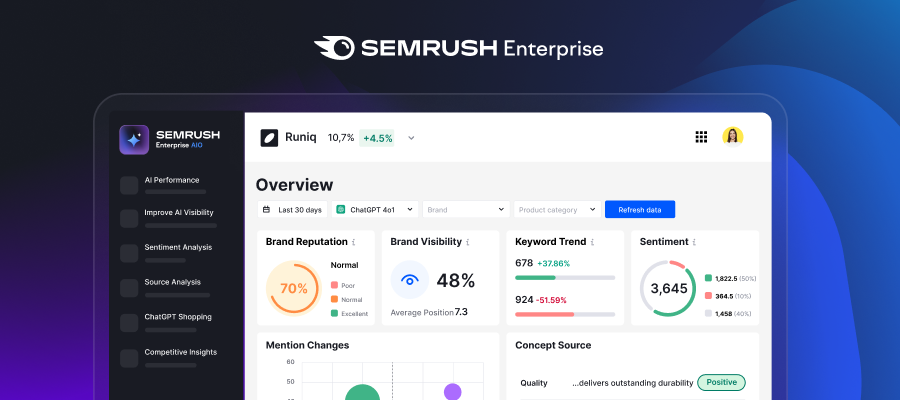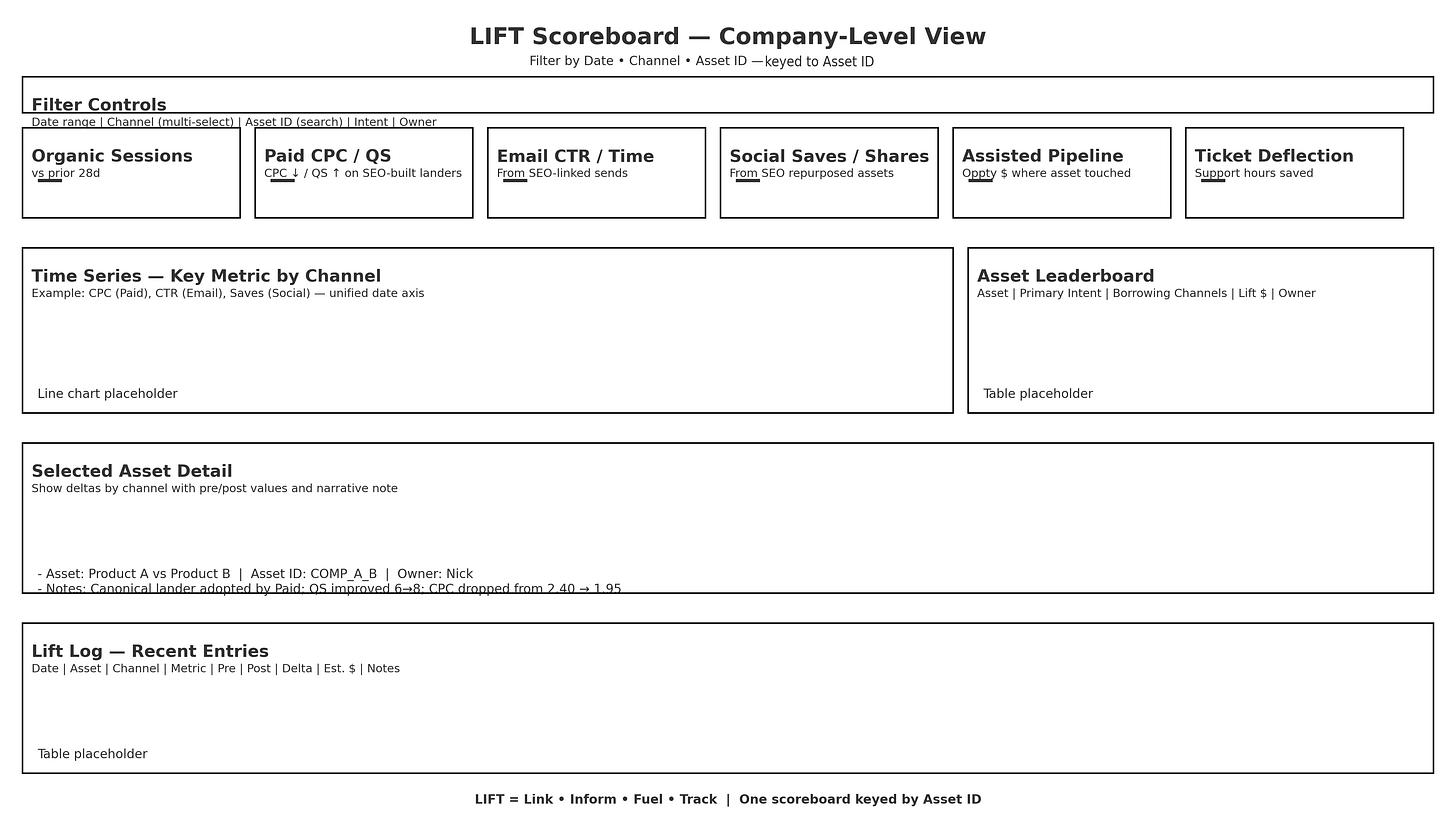Is Your SEO Team Lifting Others?
Great SEO lifts the whole funnel, not just the organic line on your dashboard
This week’s #SEOForLunch sponsor is Semrush Enterprise.Fun story. I worked with an e-commerce brand and pitched a simple idea: create content that compared the client’s flagship products to competitor products. With a few hero SKUs, it felt like a layup.
A few months in, we had a batch of these pages live. Rankings were climbing, but moving from positions 100 to page 2 does not drive clicks, let alone sales. Then came a reorg, a legal cease-and-desist, and a slow path to ROI. The project was deemed “not worth the squeeze” and ultimately shelved.
From an SEO lens, it looked “not worth it.” Then we learned how much traffic, conversion volume, and revenue the paid search team captured by using those pages as ad landing pages.
Great SEO is a company asset, not a channel win. Let’s dig in.]
A Special THANK YOU To This Weeks Sponsor: Semrush Enterprise
The Platform for Winning Search, Everywhere
For big businesses, visibility means more than rankings, and Semrush Enterprise empowers brands to own every layer of search.
By unifying SEO and AI search visibility into one platform, you get comprehensive performance tracking, live content scoring, and real-time optimization guidance. Teams can swap manual busywork for impactful strategy with advanced automations. And it’s all backed by the market’s leading search database.
It’s how leaders become dominant across both search engines and AI.
Channel Only Goals Hide Secondary Value
Last week I wrote about how companies preach collaboration but reward competition. When collaboration is not rewarded, teams protect their own metrics and work in silos. That mindset creates missed opportunities and lost revenue.
Hear me out. In the story above, the strategy and execution lived inside the organic search lane. Teams were fragmented and rarely talked. Judged on SEO-only KPIs, shutting the project down seemed reasonable. Later, we discovered those same assets were a gold mine for paid search. We killed the golden goose without knowing it. Anyone who works with/for enterprise companies knows it’s not as easy to “just restore” these. They were gone.
The good news: this company now plans organic and paid together. We are, years later, even building a V2 of the comparison strategy, but the goal is different this time. Instead of chasing SEO wins, we are optimizing for company outcomes. Success is measured by total clicks, conversions, and revenue across channels, not just the organic channel.
What “Lifting Others” Looks Like
This is not a “be nice to your coworkers” lecture. It is a tactical, cross-channel approach to building assets that create company-level value.
Not every project will lift all boats, but these common SEO moves often do:
Paid: Strong information architecture and intent-matched pages improve ad relevance and landing page experience, which raises Quality Score, lowers CPC, and lifts conversion.
Email: Pillar content powers nurture sequences, win-back flows, and seasonal campaigns without reinventing the brief each time.
Social and PR: Research pieces, benchmarks, and visuals repurpose cleanly into posts and pitches that earn mentions and links.
Sales and Support: Comparison pages and help docs shorten sales cycles and deflect tickets, saving time and headcount.
My client stumbled into this by accident. The better path is to plan it by utilizing the LIFT framework.
The LIFT Framework
SEO lifts the whole company when it is planned, not lucked into. Use LIFT from day one so work is linked across teams, informed by research, fueled by reusable assets, and tracked on a single scoreboard.
L — Link planning across teams
Goal: Align on problems, owners, and success criteria before projects are scoped.
Ritual: 30-minute monthly planning with SEO, Paid, Lifecycle/Email, Social, PR, Sales, and Support.
Deliverables: One shared backlog with tickets labeled by channel. Clear owner and due date.
Checklist to start this week: Identify one campaign where SEO supplies the landing page. Confirm audience, offer, KPI, and UTM plan.
I — Inform with research and testing
Goal: Turn SEO research into insights other teams can act on.
Inputs: Query intent maps, competitor SERP teardowns, internal site search, FAQ mining, A/B testing learnings.
Deliverables: A one-pager per theme with “Top intents,” “Page type to build,” “Headlines that match query,” “Common objections,” and “Recommended modules.”
Checklist to start this week: Ship one insight pack for an upcoming campaign and share it in team Slack with a short loom.
F — Fuel with reusable assets
Goal: Build once, reuse everywhere.
Assets: Comparison hubs, “vs” pages, alternatives pages, calculators, benchmark studies, help docs.
Packaging: Each brief includes reuse notes for Paid, Email, Social, PR. Include raw copy blocks, images, tables, and a variant for ad landers.
Checklist to start this week: Pick one existing SEO page and add a paid-ready variant (tight header, proof bullets, single CTA) plus a 5-tile social cut.
T — Track company-level lift
Goal: Prove impact beyond organic KPIs.
Shared view: One Looker Studio page with tiles for Organic, Paid, Email, Social, Sales, Support tied to the same asset IDs.
Lift Log columns: Date, Asset URL, Channel using it, Metric moved, Pre value, Post value, Delta, Estimated revenue impact, Owner.
Checklist to start this week: Log two assets already reused by another channel and record a simple pre/post delta.
Most of you already run a version of this inside your own channel. Extending it cross-channel will feel familiar. Best practices are nice, but seeing this in action flips behavior faster.
Ops That Make It Real
Reality check: great ideas die without process. Put lightweight routines in place so LIFT shows up in day-to-day work. Here are a few examples of LIFT in action:
Monthly cross-channel backlog with owners and due dates.
Hold a 45-minute planning session to load one shared board, choose 4–6 priority assets, and assign a single owner and due date to each. This kills duplicate work, clarifies handoffs, and makes LIFT visible on the calendar.
Content brief with explicit fields for Paid, Email, and Social reuse.
Add reuse fields to every brief so teams get ad headlines, email snippets, social cuts, PR hooks, and required modules in one place. You build once, and every channel ships faster with fewer rewrites.
Landing page and UTM governance so every channel benefits from SEO UX.
Create a designated landing page per intent, enforce UTM standards tied to an Asset ID, and hold a quick QA before launch. Paid gets higher Quality Scores, analytics gets clean data, and everyone reports against the same page!
30-minute weekly office hours between SEO, Paid, and Lifecycle.
Meet live, review the backlog, unblock decisions, and confirm next week’s commitments. No slides. This keeps momentum high and prevents “great idea, died in Slack” syndrome.
Most importantly, pause to celebrate the efficiency gains and cross-channel wins. That recognition reinforces the habit. Now let’s make it undeniable with numbers.
Proving the Lift
Process creates consistency. Measurement creates belief. Here’s how to turn a good idea into 100% buy-in with real business numbers.
Track the right channel metrics.
Paid: CPC, Quality Score, conversion rate on SEO-built or SEO-optimized landers.
Email: CTR, time on page after click, unsubscribe rate.
Social: saves, shares, profile visits following SEO content posts.
Sales: assisted pipeline, time to close when the asset appears in the journey.
Support: ticket deflection and article satisfaction for help docs.
Use simple pre-/and post-windows.
Pick a 14 or 28 day window before and after the asset goes live or gets reused. Same channels. Same audience. Same offer. Note any major promos that could skew results.
Keep a Lift Log that everyone can read.
Columns: Asset name/URL, Asset ID, Borrowing channel, Metric moved, Pre value, Post value, Delta, Dollar estimate, Owner, Notes.
Rule: if it is not in the log, it did not happen. (This is my personal philosophy for my calendar, too!)
Convert lifts to dollars with back-of-napkin math.
CPC savings: (Old CPC − New CPC) × Paid clicks
CVR lift: (New CVR − Old CVR) × Sessions × AOV × Margin
QS lift proxy: estimate CPC reduction from QS change × clicks
Ticket deflection: Deflected tickets × Avg. handle time × Cost per minute (Directionally true beats perfectly unmeasurable).
Note: I created a really basic Google sheet so you can see what a LIFT report looks like in action. Feel free to make a copy and take it to the next level.
One shared scoreboard.
A single Looker Studio report isolating the asset ID that shows Organic, Paid, Email, Social, Sales, and Support tiles in the same time range. Short narrative per asset: what changed and why.
Here is a wireframe for what this might look like. Nothing crazy, but it does a good job of visually showing everything above.
The only thing left is taking action.
You ready for this?




